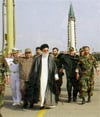
The noisy propaganda by the faltering regime about launching satellite is a ploy with dual use of hollow show of force and deception. The mullahs are trying to claim that they are making progress in the field of science and aerospace while covering up their missile tests capable of carrying nuclear warheads.
The missiles are manufactured by the Mot'al Industry Group (the Center for Advanced Electronic Research) of the Defense Ministry. Their production site is located in Beheshti Garrison (near the ordnance division) on Tehran's Pasdaran Street. The Defense Ministry also uses the research centers at Sharif University of Technology (SUT), Iran University of Science and Technology (IUST) and Amirkabir University of Technology (AUT), for production of these missiles.
Despite demagogic propaganda, the regime is facing serious problems with production and launching of satellite. The most important problem is the fact that the military missiles can only carry satellites to an altitude of not more than 300 km. Thus, satellites such as Omid, only last a short while. The required altitude for communication satellites is between 600 and 700 km.
The regime is faced with serious difficulties in reaching the advanced technology-related parts due to international sanctions. Those involved in the satellites' project underline the inefficiency of the parts readily available. They say that their laboratory test results on the parts are far different from those achieved when launched or put under atmospheric radiation.
Secretariat of the National Council of Resistance of Iran
February 2, 2010


